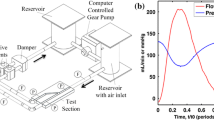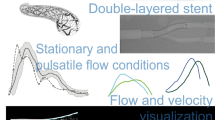Abstract
Purpose
In this study, in vitro experiments and computational fluid dynamic (CFD) simulations are used to expand the understand of the physics of saline flushing of a blocked artery to enable optical imaging. This process involves saline injection, mixing with blood, and advection of the mixture away from the region of interest to provide a clear optical path for imaging.
Methods
CFD simulations are used as a rapid turn-around tool for the evolutionary design process of an endovascular catheter that combines imaging forward-viewing element with saline flushing lumens.
Results
A novel design and control technique is developed that provides the method to regulate the pressure in a blocked artery during saline flushing, so only small deviations from physiological pressure values are exerted on the damaged artery wall at any time, minimizing risk of rupture. In vitro experiments demonstrate the optical clearing process in phantoms simulating chronic total occlusions (CTOs) in coronary arteries with an opaque blood surrogate being removed by saline flushing. With the CFD compared by the experiments, parametric analyses of artery diameter and curvature, and flushing lumen diameter size were conducted to understand their impact on flushing times and pressures. Different plaque morphologies were studied to explore the feasibility of saline flushing in different CTO conditions.
Conclusions
A new catheter design is demonstrated to safely and effectively produce saline flushing, leading to a clear optical imaging field, and an improved technique is outlined that overcomes some practical challenges and limitations commonly encountered in angioscopy.










Similar content being viewed by others
References
Burke, A. P., A. Farb, G. T. Malcom, Y.-H. Liang, J. E. Smialek, and R. Virmani. Plaque rupture and sudden death related to exertion in men with coronary artery disease. JAMA 281(10):921–926, 1999.
Chin, A. K. Endoscopic Techniques and Technology in Cardiac Surgery. Cardiovasc. Eng. Technol. 1(1):66–76, 2010.
Davies, M. J., and A. C. Thomas. Plaque fissuring–the cause of acute myocardial infarction, sudden ischaemic death, and crescendo angina. Br. Heart J. 53(4):363, 1985.
Fefer, P., et al. Current perspectives on coronary chronic total occlusions: the Canadian Multicenter Chronic Total Occlusions Registry. J. Am. Coll. Cardiol. 59(11):991–997, 2012.
Fernandez, J. P., et al. “Beyond the balloon: excimer coronary laser atherectomy used alone or in combination with rotational atherectomy in the treatment of chronic total occlusions, non-crossable and non-expansible coronary lesions. EuroIntervention 9(2):243–250, 2013.
Filipce, V., P. Pillai, O. Makiese, H. Zarzour, M. Pigott, and M. Ammirati. Quantitative and qualitative analysis of the working area obtained by endoscope and microscope in various approaches to the anterior communicating artery complex using computed tomography-based frameless stereotaxy: a cadaver study. Neurosurgery 65(6):1147–1153, 2009.
Flory, C. M. Arterial occlusions produced by emboli from eroded aortic atheromatous plaques. Am. J. Pathol. 21(3):549, 1945.
Fracassi, F., M. Roberto, and G. Niccoli. Current interventional coronary applications of excimer laser. Expert Rev. Med. Devices 10(4):541–549, 2013.
Ghata, N., R. C. Aldredge, J. Bec, and L. Marcu. Computational analysis of the effectiveness of blood flushing with saline injection from an intravascular diagnostic catheter. Int. J. Numer. Methods Biomed. Eng. 30(11):1278–1293, 2014.
Kalniņš, A., I. Strele, I. Kurcalte, A. Lejnieks, and A. Erglis. Chronic total coronary artery occlusion recanalisation with percutaneous coronary intervention—single centre 10-year experience. Proceedings of the Latvian Academy of Sciences. Section B. Natural, Exact, and Applied Sciences, vol. 72, no. 1: Sciendo, pp. 1–8, 2018.
Kawase, Y., et al. In vivo volumetric analysis of coronary stent using optical coherence tomography with a novel balloon occlusion-flushing catheter: a comparison with intravascular ultrasound. Ultrasound Med. Biol. 31(10):1343–1349, 2005.
Kennedy, I. K. C., T. E. Dillon, and A. Mitra. Space-optimized visualization catheter with oblong shape. ed: Google Patents, 2017.
Lee, C. M., C. J. Engelbrecht, T. D. Soper, F. Helmchen, and E. J. Seibel. Scanning fiber endoscopy with highly flexible, 1 mm catheterscopes for wide-field, full-color imaging. J. Biophotonics 3(5–6):385–407, 2010.
McVeigh, P. Z., et al. High-resolution angioscopic imaging during endovascular neurosurgery. Neurosurgery 75(2):171–180, 2014.
Mozaffarian, D., et al. “American heart association statistics committee and stroke statistics subcommittee,” Heart disease and stroke statistics–2015 update: a report from the American Heart Association. Circulation 131(4):e29–e322, 2015.
Navaneethan, U., J. H. Moon, and T. Itoi. Biliary interventions using single-operator cholangioscopy. Dig. Endosc. 31(5):517–526, 2019.
Patel, V. G., et al. Angiographic success and procedural complications in patients undergoing percutaneous coronary chronic total occlusion interventions. A weighted meta-analysis of 18,061 patients from 65 Studies. JACC Cardiovasc. Interv. 6(2):128–136, 2013. https://doi.org/10.1016/j.jcin.2012.10.011.
Piper, R., P. J. Carr, L. J. Kelsey, A. C. Bulmer, S. Keogh, and B. J. Doyle. The mechanistic causes of peripheral intravenous catheter failure based on a parametric computational study. Sci. Rep. 8(1):1–12, 2018.
Ramaswamy, S., et al. Fluid dynamic analysis in a human left anterior descending coronary artery with arterial motion. Ann. Biomed. Eng. 32(12):1628–1641, 2004.
Rees, M. R., and L. K. Michalis. Activated-guidewire technique for treating chronic coronary artery occlusion. Lancet (London, England) 346(8980):943–944, 1995.
Sadeghi, M., et al. Total resuscitative endovascular balloon occlusion of the aorta causes inflammatory activation and organ damage within 30 minutes of occlusion in normovolemic pigs. BMC Surg. 20(1):1–11, 2020.
Sakes, A., M. van der Wiel, D. Dodou, and P. Breedveld. Endovascular crossing of chronic total occlusions using an impulse: an explorative design study. Cardiovascular Engineering and Technology 8(2):145–163, 2017.
Savastano, L. E., et al. Multimodal laser-based angioscopy for structural, chemical and biological imaging of atherosclerosis. Nat Biomed. Eng. 1(2):1–15, 2017.
Shen, Z. J., H. M. García-García, C. Schultz, M. Van Der Ent, and P. W. Serruys. Crossing of a calcified “balloon uncrossable” coronary chronic total occlusion facilitated by a laser catheter: A case report and review recent four years’ experience at the Thoraxcenter. Int. J. Cardiol. 145(2):251–254, 2010.
Sianos, G., et al. European experience with the retrograde approach for the recanalisation of coronary artery chronic total occlusions. A report on behalf of the euroCTO club. EuroIntervention 4(1):84–92, 2008.
Stone, G. W., et al. Percutaneous recanalization of chronically occluded coronary arteries: procedural techniques, devices, and results. Catheter. Cardiovasc. Interv. 66(2):217–236, 2005.
Suero, J. A., et al. Procedural outcomes and long-term survival among patients undergoing percutaneous coronary intervention of a chronic total occlusion in native coronary arteries: a 20-year experience. J. Am. Coll. Cardiol. 38(2):409–414, 2001.
Touma, G., D. Ramsay, and J. Weaver. Chronic total occlusions—current techniques and future directions. IJC Heart Vasc. 7:28–39, 2015.
Watts, D., and A. Cash. Analysis of optical transmission by 400–500 nm visible light into aesthetic dental biomaterials. J. Dent. 22(2):112–117, 1994.
Weber, P. W., C. A. Coursey, L. E. Howle, R. C. Nelson, E. B. Nichols, and S. T. Schindera. Modifying peripheral IV catheters with side holes and side slits results in favorable changes in fluid dynamic properties during the injection of iodinated contrast material. Am. J. Roentgenol. 193(4):970–977, 2009.
Whitlow, P. L., et al. Use of a novel crossing and re-entry system in coronary chronic total occlusions that have failed standard crossing techniques: results of the FAST-CTOs (Facilitated Antegrade Steering Technique in Chronic Total Occlusions) trial. JACC Cardiovasc. Interv. 5(4):393–401, 2012.
Wolinsky, H., and S. N. Thung. Use of a perforated balloon catheter to deliver concentrated heparin into the wall of the normal canine artery. J. Am. Coll. Cardiol. 15(2):475–481, 1990.
Yamaguchi, T., et al. Safety and feasibility of an intravascular optical coherence tomography image wire system in the clinical setting. Am. J. Cardiol. 101(5):562–567, 2008.
Zaman, A., G. Helft, S. Worthley, and J. Badimon. The role of plaque rupture and thrombosis in coronary artery disease. Atherosclerosis 149(2):251–266, 2000.
Acknowledgments
Funding was provided by the University of Washington CoMotion Innovation Fund (PI Aliseda) and Phase 1 SBIR 1R43HL139323-01 (PI McMorrow, subcontract to Seibel). We acknowledge Dr. John Petersen II for providing clinical advice to the team. We also acknowledge Erik Hagstrom for industrial advice, and Matt Carson and Cathy Olivo for assistance with the design and setup of the in vitro experiment.
Funding
Funding was provided by the University of Washington CoMotion Innovation Fund (PI Aliseda) and Phase 1 SBIR 1R43HL139323-01 (PI McMorrow, subcontract to Seibel).
Data Availability
All data was generated by the study or used via reference from previously published literature.
Code Availability
Software used: MATLAB (Mathworks Inc., Natick, MA) StarCCM++ (CD-Adapco/Siemens, Melville, NY).
Author information
Authors and Affiliations
Corresponding author
Ethics declarations
Conflict of interest
The authors are co-inventors of a patent (Application Number is 17/311,308) owned by the University of Washington and participate in a royalty sharing program at the University of Washington.
Additional information
Associate Editor Ajit P. Yoganathan oversaw the review of this article.
Publisher's Note
Springer Nature remains neutral with regard to jurisdictional claims in published maps and institutional affiliations.
Supplementary Information
Below is the link to the electronic supplementary material.
Rights and permissions
About this article
Cite this article
Faisal, S., Seibel, E.J. & Aliseda, A. Optimization Study of the Hemodynamics of Saline Flushing in Endoscopic Imaging of Chronic Total Occlusions (CTOs). Cardiovasc Eng Tech 12, 541–555 (2021). https://doi.org/10.1007/s13239-021-00550-x
Received:
Accepted:
Published:
Issue Date:
DOI: https://doi.org/10.1007/s13239-021-00550-x




